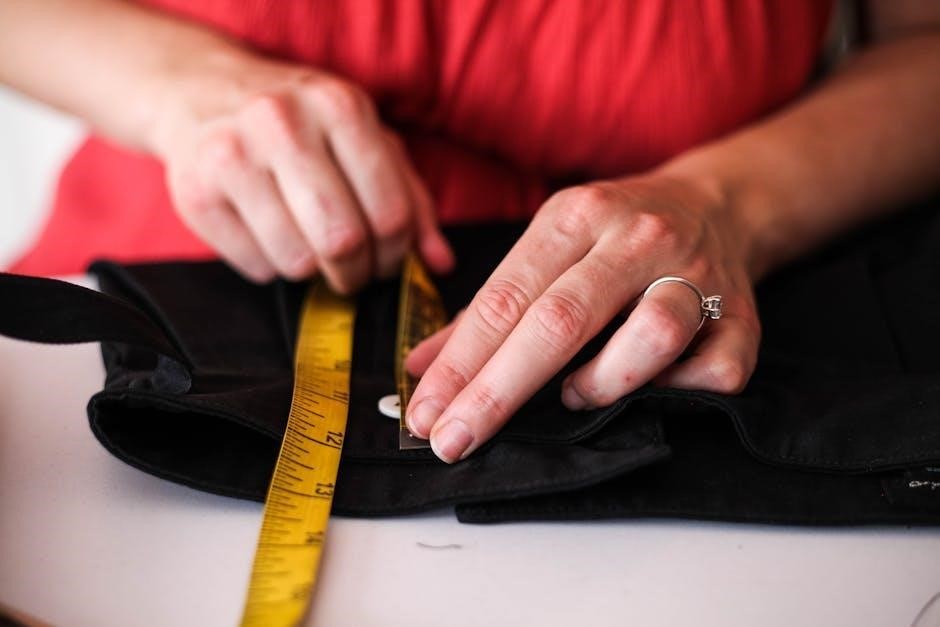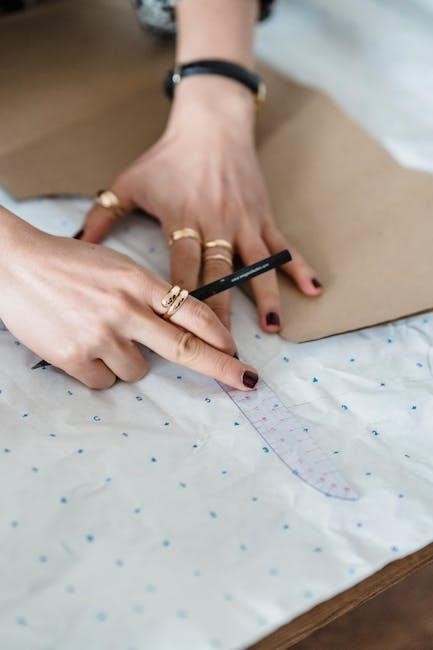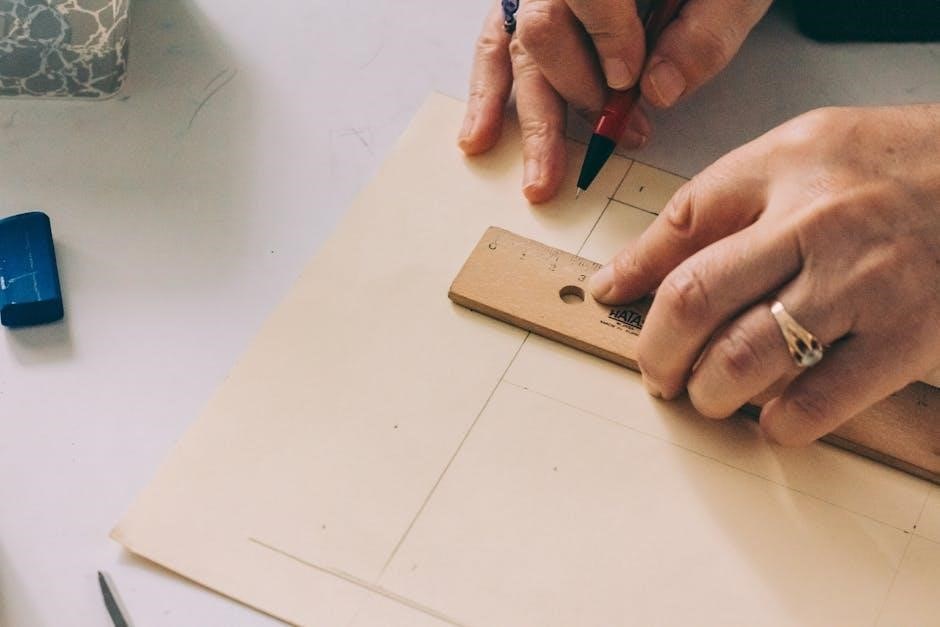Learn how to accurately measure your ring size using simple tools like a tape measure, string, or printable chart. Ensure a perfect fit for comfort and style with our expert tips and international size conversions.
Ring sizing is a crucial step in ensuring a perfect fit for any ring. Whether you’re purchasing an engagement ring, a wedding band, or a fashion accessory, accurate sizing ensures comfort and proper appearance. Rings come in various sizes, and finding the right fit involves understanding measurements, tools, and techniques. This guide provides a comprehensive overview of ring sizing, including methods like using a tape measure, printable charts, or a ring sizer tool. Additionally, it covers how to measure an existing ring and interpret international size charts. By following these steps, you can determine your ring size confidently, avoiding the need for resizing. Proper sizing also considers factors like finger shape and daily fluctuations, ensuring your ring feels comfortable throughout the day. With the right tools and knowledge, achieving the ideal fit is straightforward and stress-free.
Why Accurate Ring Measurement is Important
Accurate ring measurement is essential to ensure a comfortable and proper fit. A ring that is too tight can cause discomfort or even restrict blood flow, while one that is too loose may slip off easily. Correct sizing prevents costly resizing and ensures the ring stays in pristine condition. Additionally, accurate measurement avoids the hassle of returns and exchanges, especially when shopping online. Proper fit also enhances the ring’s appearance, making it look more flattering on the finger. Considering factors like finger shape and daily size fluctuations due to temperature or activity levels, precise measurement is key. International size variations further emphasize the need for accurate sizing to match global standards. By taking the time to measure correctly, you ensure a perfect balance of comfort, style, and longevity for your ring.

Methods to Measure Your Ring Size
Measure your ring size using a tape measure, string, or printable chart. You can also use a ring sizer tool or measure an existing ring for accurate results.
Using a Tape Measure or String
Wrap a flexible tape measure or a piece of string snugly around the base of your finger, marking where the ends meet. Lay the string flat and measure its length in millimeters. Compare this to a ring size chart to find your size. For best results, measure at the end of the day when fingers are at their largest. Ensure the fit is comfortable, not too tight or loose. If using a string, tie it gently and slide it off to measure. This method is simple and effective for determining your ring size accurately. Always consider the ring’s width, as wider bands may require a slightly larger size for comfort. Double-check your measurement to ensure the perfect fit.
Measuring with a Printable Ring Size Chart
Download and print a printable ring size chart on standard 8.5 x 11-inch paper, ensuring the scaling is set to 100% for accuracy. Cut out the chart and place a ring that fits comfortably on the intended finger over the circular size guides. Align the inner edge of the ring with the circles on the chart until you find a match. This method provides a visual confirmation of your ring size. Many charts include international size comparisons, making it easy to determine your size in different countries. For the best results, use a ring that fits well and measure in a well-lit area. If unsure, consult a professional jeweler to ensure precision. This method is ideal for those without access to a tape measure or string.
How to Use a Ring Sizer Tool
A ring sizer tool, often called a ring mandrel, is a precise way to measure ring size. Place the ring on the tool, ensuring it sits flush against the mandrel. Measure the inner diameter of the ring, which corresponds to your finger size. This method is ideal for existing rings and provides accurate results. For those without a ring, slips the tool onto your finger and adjust until snug, then read the size. Always measure at the end of the day for the most accurate fit. This tool is commonly used by jewelers and ensures a perfect size match. For best results, use a ring that fits comfortably and measure in a well-lit area. If unsure, consult a professional jeweler to ensure precision. This method is ideal for those without access to a tape measure or string.
Measuring an Existing Ring
To measure an existing ring, start by selecting a ring that fits the finger you wish to size. Place the ring on a flat surface and measure its inner diameter using a ruler or calipers in millimeters. Compare this measurement to a ring size chart to determine the corresponding size. For accuracy, ensure the chart is printed at 100% scaling. If the ring’s diameter falls between two sizes, choose the larger size for comfort. This method is ideal for those who already own a well-fitting ring. To enhance precision, use a ring sizer tool or consult a professional jeweler. Always measure at the end of the day for the most accurate results, as finger size can vary. This approach ensures a perfect fit and eliminates the need for guesswork. It’s a reliable way to determine your size without additional tools or materials.

Understanding Ring Size Charts
Ring size charts help convert finger measurements into standard sizes. They provide a reference for matching inner diameters or circumferences to corresponding ring sizes, ensuring accurate fits for any ring style.
How to Read a Ring Size Chart
Reading a ring size chart involves matching your finger measurement to the corresponding size. Start by measuring your finger’s circumference or the inner diameter of a well-fitting ring. Use a tape measure or string to wrap around the base of your finger, ensuring a snug fit. Lay the string flat and measure its length in millimeters. Compare this measurement to the chart, which lists sizes based on circumference or diameter; For example, a 54 mm circumference corresponds to a size 7 in the US system. Charts often include international comparisons, such as UK or EU sizes, to help with conversions. Pay attention to the numbering system, as some charts use letters (e.g., Q, R) or numerical values. Always consider the ring’s width, as wider bands may require a slightly larger size for comfort. If unsure, consult a professional jeweler for precise sizing.
International Ring Size Comparison
Ring sizes vary across countries, making it essential to understand the differences when shopping internationally. The U.S. uses numerical sizes (e.g., 6, 7, 8), while the UK and Australia use alphabetical sizes (e.g., L, M, N). European countries often use millimeter measurements based on the ring’s inner diameter. For example, a size 7 in the U.S. corresponds to a size M in the UK and 17-18 mm in Europe. To avoid confusion, refer to an international ring size chart or conversion tool. These charts align numerical, alphabetical, and millimeter measurements, ensuring accurate sizing. When purchasing from another country, double-check the sizing system to match your local ring size. This comparison guide helps you navigate global sizing differences seamlessly, whether you’re shopping online or in-store.
Ring Size Conversion Between Countries
Understanding ring size conversion between countries is crucial for accurate sizing. The U.S. uses numerical sizes, the UK and Australia use alphabetical, and Europe often uses millimeter measurements. A size 7 in the U.S. is equivalent to an M in the UK and 17-18 mm in Europe. For instance, a U.S. size 6 corresponds to an L in the UK and 16 mm in Europe, while a U.S. size 8 aligns with an N in the UK and 18-19 mm in Europe. Using an international ring size chart or conversion tool ensures precise matching. These tools align numerical, alphabetical, and millimeter measurements, helping avoid sizing errors. When shopping globally, referencing these charts is essential to find your correct size, ensuring a perfect fit regardless of the country’s sizing system.

Ring Sizing Tools and Resources
Explore essential tools like printable ring sizers, diameter calculators, and conversion charts to determine your ring size accurately. These resources ensure a perfect fit for any occasion.
Printable Ring Sizer
A printable ring sizer is a convenient tool to measure your ring size at home. Download and print the chart on standard 8.5 x 11 paper, ensuring the scaling is set to 100% for accuracy. Cut out the ring sizer strip or use the circular guide. Wrap the strip around your finger or place an existing ring over the circles to find your size. Match the inner diameter of the ring to the circles on the chart to determine your size. This method is ideal for those without a ruler or tape measure. For best results, measure at the end of the day when fingers are at their largest. Printable ring sizers are widely available online and provide a quick, reliable way to ensure a perfect fit for your ring. Always double-check your measurements for accuracy.
Ring Diameter Calculator
A ring diameter calculator is a handy tool for determining your ring size by measuring the internal diameter of a ring; Simply measure the inner diameter of a ring that fits you using a ruler, then input the measurement into the calculator. It will convert the diameter into your corresponding ring size. This method is particularly useful if you already own a well-fitting ring. The calculator provides instant results, saving time and ensuring accuracy. Many calculators also offer international size conversions, making it easy to shop across brands worldwide. Whether you’re purchasing a new ring or resizing an existing one, a ring diameter calculator is a reliable resource for achieving the perfect fit. It’s a quick and straightforward way to ensure your ring size is accurate and comfortable.
Ring Size Conversion Chart
A ring size conversion chart is essential for comparing sizes across different countries and regions. Since ring sizing varies internationally, this chart helps translate US sizes to UK, EU, or Australian sizes seamlessly. For instance, a size 6 in the US corresponds to an M in the UK and 16.5 in Europe. The chart typically includes measurements in millimeters and inches, providing a comprehensive reference. It’s particularly useful when shopping from international brands or gifting someone abroad. By using a conversion chart, you can ensure accuracy and avoid resizing. This tool is a must-have for anyone looking to buy or wear rings comfortably across borders. It simplifies the process of finding the perfect fit regardless of the country’s sizing standards, making it a valuable resource for both buyers and jewelers alike.
Tips for Accurate Ring Measurement
Measure your finger at the end of the day for accuracy. Ensure the ring sits comfortably, considering knuckle size and style. Avoid cold hands and tight fittings.
Best Time to Measure Your Finger
Measure your finger in the late morning or early afternoon for accuracy. Avoid measuring when your hands are cold or swollen, as this can lead to incorrect sizing. Consistency ensures the best fit.
How to Ensure a Comfortable Fit
Measure your finger at the end of the day when it’s at its largest. Avoid sizing when hands are cold, as fingers are smaller. Consider the ring’s width; thicker bands may require a larger size. Ensure the ring slides on easily but isn’t too loose. For comfort, opt for a slightly snug fit that allows movement. If unsure, size up to avoid tightness. Test the ring on both hands, as dominant hands may differ. Adjustments can be made later, but starting with the right fit ensures comfort and satisfaction. Proper sizing balances style and wearability, making the ring enjoyable to wear daily.
Factors Affecting Ring Size
Several factors influence ring size, including temperature, weight fluctuations, and finger shape. Hands tend to swell in heat and shrink in cold, so measure at room temperature. Weight changes can alter finger size, requiring resizing. The time of day matters, as fingers are typically larger in the evening. The ring’s width also impacts fit; wider bands may need a larger size for comfort. Additionally, genetic factors and knuckle size play a role, as larger knuckles may require a slightly looser fit. International sizing differences mean sizes vary between regions, so always refer to the specific chart for accuracy. These factors highlight the importance of precise measurement for a comfortable and secure fit. Understanding them ensures your ring feels right and looks great. Proper sizing considers all these elements to provide a perfect balance of comfort and style.
FAQs About Ring Sizing
Discover answers to common questions about ring sizing, including how to measure without a ring, differences in sizes between hands, and resizing options for a perfect fit.
How to Determine Ring Size Without a Ring
If you don’t have a ring to measure, you can determine your size using a tape measure or string. Wrap it snugly around the base of your finger, marking where it overlaps. Lay the string flat and measure its length in millimeters. Compare this measurement to a ring size chart to find your size. For accuracy, measure at the end of the day when fingers are at room temperature. If unsure, consider sizing up slightly for comfort. This method ensures a precise fit without an existing ring, making it ideal for surprise gifts or online purchases.
Can Ring Sizes Differ Between Hands?
Yes, ring sizes can differ between hands due to natural variations in finger size. The dominant hand often has slightly larger fingers, while the non-dominant hand may be smaller. Environmental factors, such as temperature, can also cause temporary changes. Measure each finger separately to ensure accuracy. If the ring is for the left hand, measure the left finger, and vice versa. This ensures the best fit, as relying on one hand’s size may lead to discomfort or improper sizing. Always consider the specific finger the ring will be worn on, as even adjacent fingers can vary in size. For the most precise fit, measure at the end of the day when fingers are at their largest.
How to Resize a Ring
Resizing a ring involves adjusting its circumference to fit the finger perfectly. A jeweler typically cuts the band, adjusts the metal, and solders it back together. The process varies based on the ring’s design and metal type. Simple bands are easier to resize, while intricate or eternity rings may require more complex adjustments. Resizing can make the ring larger or smaller, but some metals, like tungsten, cannot be resized. It’s important to consult a professional jeweler to ensure the ring’s integrity remains intact. They will assess the ring’s structure and recommend the best method. Keep in mind that resizing can slightly alter the ring’s appearance and may require additional repairs. Always choose a reputable jeweler for precise and durable results.

Additional Resources
Explore downloadable ring size guides, video tutorials, and expert consultations to ensure precise measurements and a perfect fit for your jewelry needs.
Downloadable Ring Size Guides
Downloadable ring size guides provide a convenient and accurate way to measure your ring size at home. These guides are available as printable PDFs and often include detailed instructions. To use them, print the guide on standard 8.5 x 11-inch paper, ensuring the scaling is set to 100% for accuracy. Once printed, you can compare an existing ring to the size circles or use the included paper sizer to measure your finger. Many guides also offer international size comparisons, making it easy to convert between U.S., U.K., and European sizes. Some guides include additional features like diameter calculators and fit tips. For the best results, measure your finger at the end of the day when it is at its largest. These tools are especially helpful for online shoppers or those surprising a loved one with a ring. Always verify the accuracy of your measurements for a perfect fit.
Video Tutorials for Ring Measurement
Video tutorials offer a visual and step-by-step guide to measuring your ring size accurately. These tutorials demonstrate methods such as wrapping a string around your finger, using a tape measure, or comparing an existing ring to a size chart. Many videos also show how to use printable ring sizers or diameter calculators for precise measurements. Expert jewelers often share tips on best practices, such as measuring at the end of the day for accuracy and ensuring the ring sits comfortably. Videos may also cover international size conversions, helping you understand differences between U.S., U.K., and European sizing systems. By watching these tutorials, you can confidently determine your ring size and ensure a perfect fit. They are particularly useful for those who prefer visual learning or need guidance on resizing or converting sizes. Videos are an excellent resource for anyone looking to measure their ring size accurately and efficiently.
Jeweler Consultation for Precise Sizing
Consulting a professional jeweler ensures precise ring sizing, leveraging their expertise for a perfect fit. Jewelers use specialized tools like ring mandrels and precision calipers to measure finger circumference and existing rings. They consider factors such as knuckle size, finger shape, and personal comfort preferences. During a consultation, jewelers can also resize rings or adjust styles to accommodate unique finger characteristics. Many jewelers provide international size conversions, making it easier to shop across borders. Their deep understanding of sizing systems and materials ensures accuracy, especially for intricate designs or non-standard fits. Visiting a jeweler is highly recommended for engagement rings, wedding bands, or high-value pieces where fit is crucial. Their personalized service offers reassurance, delivering a ring that feels tailored to your hand. This method is ideal for those seeking a flawless fit without the risk of guesswork or online measurement errors.
Accurate ring measurement ensures a perfect fit and lasting comfort. Use tools like tape measures, printable charts, or consult jewelers for precise sizing. Confidence in your ring size comes from careful measurement and expert guidance.
Final Thoughts on Ring Measurement
Accurate ring measurement is crucial for comfort and fit. Use a tape measure or string wrapped snugly around your finger, ensuring it’s neither too tight nor too loose. Printable charts offer a visual guide, but ensure proper scaling for accuracy. Measuring an existing ring’s inner diameter with a ruler can also provide reliable results. Consider timing, as finger size varies throughout the day, typically smaller in the morning and larger in the evening. Comfort is key; the ring should not restrict blood flow. Be aware that international sizes differ, so use conversion charts when necessary. If unsure, consult a jeweler for precise sizing, especially for special occasions like engagements. Combining methods enhances accuracy, and remembering that resizing is possible, though limited by design and metal type, can provide peace of mind.

Leave a Reply